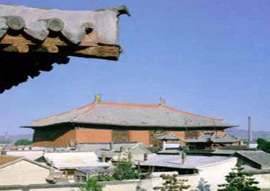Huayan Temple, lying in the western part of town, got its name because it was, and remains a major  temple of the Huayan sect, a sub-category of the Buddhism popular in north China. This is the largest and most perfectly preserved temple of the Liao (916-1125) and Jin (1115-1234) dynasties in China. The temple was originally built in the Liao Dynasty (916-1125 AD) as an ancestral temple to the imperial family, but later it became an important Buddhist temple in the ensuing Jin Dynasty (1115-1234 AD). The temple saw the prosperity in the Yuan Dynasty (1271-1368 AD) when the large-scale renovation for the temple was completed. temple of the Huayan sect, a sub-category of the Buddhism popular in north China. This is the largest and most perfectly preserved temple of the Liao (916-1125) and Jin (1115-1234) dynasties in China. The temple was originally built in the Liao Dynasty (916-1125 AD) as an ancestral temple to the imperial family, but later it became an important Buddhist temple in the ensuing Jin Dynasty (1115-1234 AD). The temple saw the prosperity in the Yuan Dynasty (1271-1368 AD) when the large-scale renovation for the temple was completed.
The large temple is divided into two parts. The Upper Temple has various halls, the largest of which is the Grand Hall, otherwise known as the Mahavira Hall which houses five large Ming Dynasty (1368-1644 AD) Buddhas, 26 guardians and numerous attractive murals. Surrounding the Grand Hall are other halls for other Buddhas, including a side hall dedicated to Ksitigarbha, the guardian of the earth who is known in China as Dizang. The Lower Temple is smaller than the upper, but has a lot of charm. |
